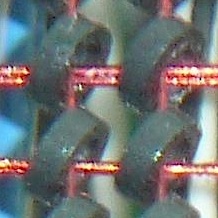
Core MemoryThe dominant technology from 1960 to 1980
by
Douglas W. Jones
|

Core MemoryThe dominant technology from 1960 to 1980
by
Douglas W. Jones
|

|
Date: 1960?
Capacity: 4K × 2
Core area per bit: 6.45 mm2
Core diameter: 1.96 mm
Memory cycle: unknown

|
Date: 1964
Capacity: 4096 × 12
Core area per bit: 1.61 mm2
Core diameter: 1.27 mm
(just fits through the hole of the early core)
Memory cycle: 6µs (potentially 4µs)

|
Date: 1965
Capacity: 4096 × 12
Core area per bit: 1 mm2
Core diameter: 0.89 mm
Memory cycle: 1.5µs

|
Date: 1970 (introduced 1968)
Capacity: 4096 × 12
Core area per bit: 0.64 mm2
Core diameter: 0.76 mm
(almost fits through the hole of the PDP-5 core)
Memory cycle: 1.6µs
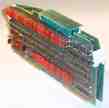
|
Date: 1970 (introduced 1969, some say 1968)
Capacity: 640 × 6
Core area per bit: 0.89 mm2
Core diameter: ?
Memory cycle: 1.6µs
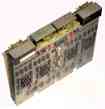
|
Date: 1972 (introduced 1970)
Capacity: 4K × 12
Core area per bit: 0.28 mm2
Core diameter: 0.51 mm
(easily fits through the hole of the 184A core)
Memory cycle: 1.2µs (1.4 µs for read-modify-write)

|
Date: 1977 (introduced 1974)
Capacity: 8K × 12
Core area per bit: 0.13 mm2
Core diameter: 0.46 mm
(almost fits through the hole of the PDP-8/L core)
Memory cycle: 1.2µs (1.4 µs for read-modify-write)
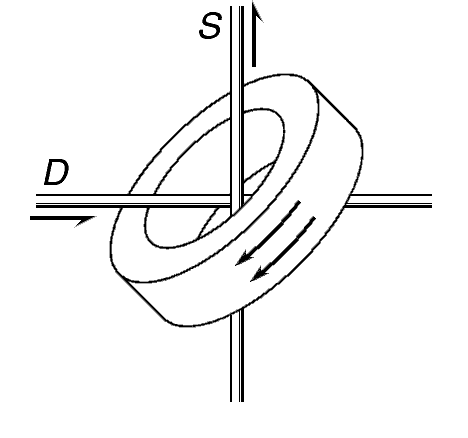
|
For the transformer to function, it must be made of a magnetic material. In a power transformer, we use soft magnetic materials, where the magnetization of the core is linearly proportional to the current through the core. If we push current through the data-in wire, it will magnetize the core, and the change in magnetization in the core will induce a voltage in the sense wire. The arrows show the direction of the current in the data-in wire, the direction in which the core is magnetized, and the direction that the voltage in the sense wire is attempting to push curent. If the sense wire is made into a loop with zero resistance, the current in the sense wire will be equal to the current in the data-in wire in such a way that the total magnetization of the core is always zero.
Hysteresis and Saturation: Real magnetic materials aren't like the ideal soft magnetic materials described above. First, they can only be magnetized up to some point. Above that point, we say that the core is saturated. Increasing the current above the saturation point doesn't increase the magnetization. Second, real ferromagnetic materials exhibit hysteresis. That is, once you apply some current to magnetize them, they tend to stay magnetized and you have to apply at least a little current in the opposite direction to get them completely demagnetized.
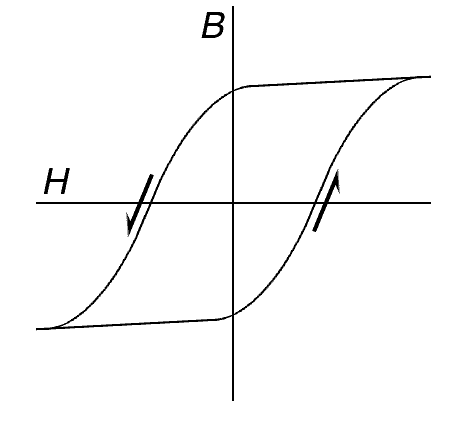
|
For hard magnetic materials, including the ferrite used in core memories, tool steel and the alloys used in permanent magnets, reducing the current H to zero leaves the core magnetized, so B is not zero. If the current is reversed to saturate the core in the opposite direction and then released, B will still be be non-zero, but now the core will be magnetized in the opposite direction.
Now, consider how a core made of a hard magnetic materal responds to a current pulse. If the core is already magnetized in the direction that current pulse would induce, the current pulse will only cause a small change in the magnetization, so only a small pulse will be seen on the sense line. In contrast, if the core is magnetized in the opposite direction, there will be a big change in the magnetization, so there will be a big pulse on the sense line.
Note: For the core memories discussed here, reading the data stored in a core always involves erasing that data. You have to set it to zero to see if it was a one. If you want the data to remain unchanged after reading, the control system must refresh the data by rewriting the bits that should be one.
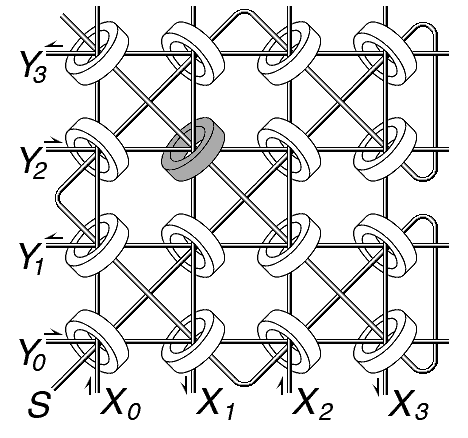
|
In the figure to the right, showing a plane of 16 cores, 4 per row. This requires 4 X select lines and 4 Y select lines. The arrows show the direction of current flow in each line when that line is used to write a one into the selected core. Applying simultaneous current pulses in this direction to the X1 and Y2 lines writes a one to just one core, shown shaded. Reversing the direction of the current pulses will write a zero to that core. There will be a pulse on the sense line of the magnetization of that core flips, and no pulse (or a much smaller pulse) if it does not.
If we are only interested in accessing one bit at a time, a read or write cycle would begin with negative pulses on both the selected X and Y lines in order to reset the addressed core to zero and read its previous value, and then a positive pulse on one select line (say the X line) with a positive pulse on the other select line (say the Y line) only when it is desired to write or restore that core to hold a one.
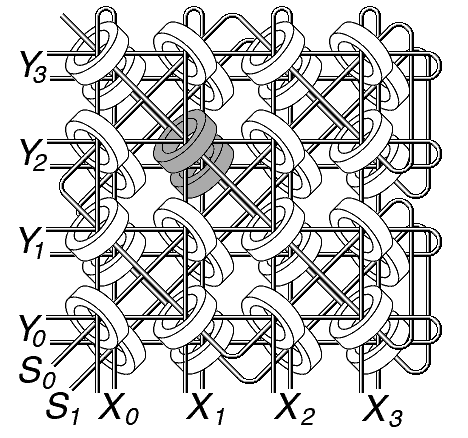
|
In wiring a core stack, the corresponding X and Y lines of each plane are wired in series, while a separate sense line is used for each plane. For example, the X1 line is threaded through the corresponding cores in both planes. Now, if we apply simultaneous pulses to the, X1 and Y2 lines, we will select two cores, one in each plane, shown shaded in the figure to the right. We can reset the sense of both cores with such a pulse, reading out their previous values on the two sense lines, S0 and S1.
The diagonal wiring of the sense line in the core plane was particularly troublesome. The meandering path through all of the cores minimizes the crosstalk between the X and Y lines and the sense line, but it prevents the cores from being tightly packed. The first wire through each row of cores, typically the X wire, could be pushed through a tightly packed stack of cores by machine, and semi-automated threading of the second wire, typically the Y wire, was pursued, but beyond that, this core layout effectively resisted automation.
Inhibit Logic:
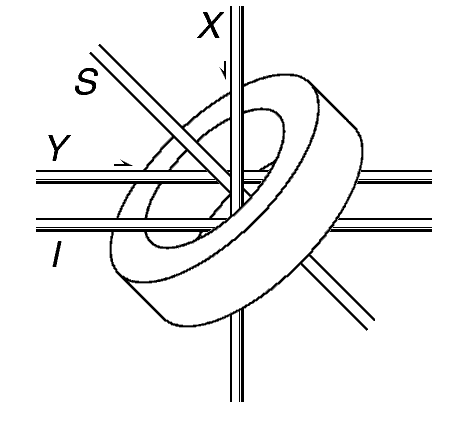
|
The inhibit wire is strung through all the wires of each core plane, parallel to one of the select lines. Here, it is shown parallel to the Y select line. When no current flows through the inhibit line, the Y select line operates normally. When it is desired to inhibit the writing of a one to this core plane, a pulse is sent on the inhibit line that is opposite to the direction of the pulse in the Y line. This prevents the pulse on the Y line from having any effect on the addressed core. Note that the pulse on the inhibit line goes through all of the cores on the same plane, so it adds to the pulses on the X select lines. For all of the non-selected X lines, where there is no pulse to add to, the amplitude is not enough to flip the cores. For the selected X line, the amplitude exactly cancels the pulse on that line, so again, no cores are flipped.
If wiring three wires through each core was difficult, wiring four wires through each core was horrible, particularly when two of those four had to pass through every core in the plane along different paths.
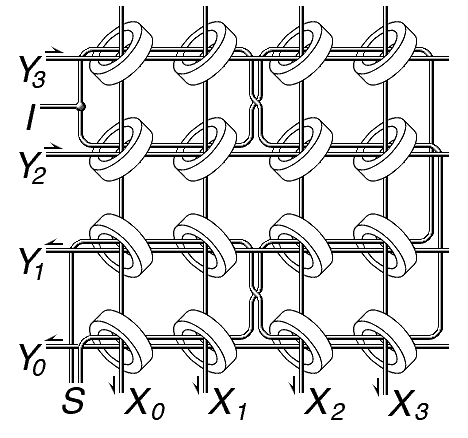
|
To combine the sense and inhibit lines, the inhibit line was center tapped.
Applying an inhibit pulse from the center tap I to the two sense ends,